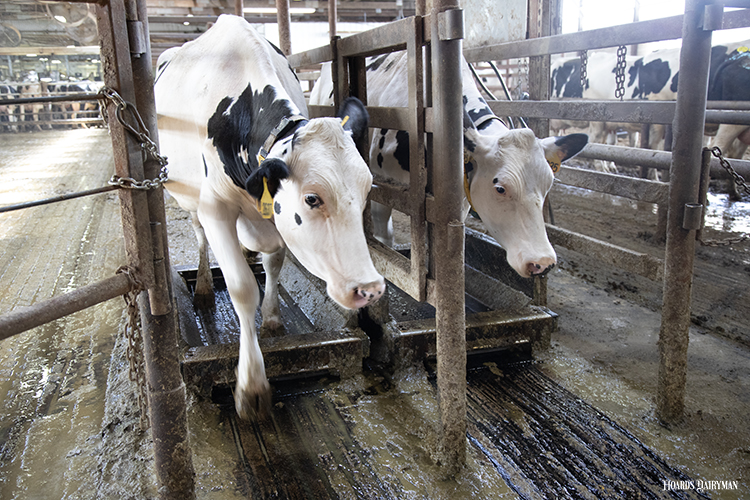
Dairy cattle need four sound feet to complete many of their daily tasks. This might be most important in robotic milking facilities, where we rely on cows to bring themselves to the robots to be milked.
Cows that don’t visit the robots often enough must be identified, located in the pen, and brought to the milking center. Fewer visits to the robot limits a cow’s milk production, and the time spent fetching cows takes away from other chores.
During a Badger Dairy Insight webinar, University of Wisconsin Division of Extension Educator Angie Ulness shared that lameness can be quite prevalent on robotic dairies if they are not using footbaths enough. Lameness leads to losses in milk production, reduced time at the feedbunk, more days open, and so on.
The general recommendations for footbaths remain the same, regardless of barn type or milking system. Ulness said footbaths should be a minimum of 10 feet long so that each foot gets two steps in the solution. The footbath should be 12 to 24 inches wide, and the solution should be maintained at a depth of 4 inches so the dew claws are submerged with each step.
The solution should be changed every 150 to 300 cows to ensure it stays clean and effective. How regularly the solution needs to be changed is somewhat dependent on the cleanliness of cows’ feet and legs as they pass through the footbath.
There are a few suitable options for solution, Ulness explained. The most commonly used is copper sulfate, as it is relatively inexpensive and has an antibacterial component that hardens the claw and keeps the skin around the foot clean.
Formalin is another solution utilized by some farms. Ulness noted it is used mainly in the summer when the solution can be mixed in a well-ventilated area, as formalin is a known carcinogen.
Zinc sulfate can be used at a wider range of concentrations. It is an acceptable footbath solution but is less commonly used because it doesn’t dissolve in water as easily, Ulness said.
If using premixed solution, Ulness reminded listeners to follow the label instructions. She also noted that with any solution, keep the pH between 3.5 and 5.5 to maintain healthy skin condition and improve treatment results.
Cows milked in parlors can easily be directed to walk through a footbath following milking. That’s because all cows travel as a group and must travel a certain path to return to the barn. In a robot barn, cows have the freedom to be milked when they want, and they can take different paths to get to and from the robot. Some robotic farms may locate the footbath in the crossover alley, but Ulness said many cows will avoid those footbaths, especially the animals that probably need treatment the most.
In a free flow robotic barn, the footbath could be placed at the exit of the robot. In a guided flow system, place the bath at the far end of the pen where it is in the only route back to the resting area. Wherever the footbath is located, Ulness recommended placing gates to divert cattle through the solution.
The bottom line is that lameness is a costly disease, Ulness said. One goal of robotic milking systems is to help cows reach that next level of production with more frequent milkings, but they can’t reach their potential if they are affected by lameness.
“Make footbath layout and location a priority when designing your robotic facility,” Ulness summarized. “Run footbaths more to fetch cows less.”








